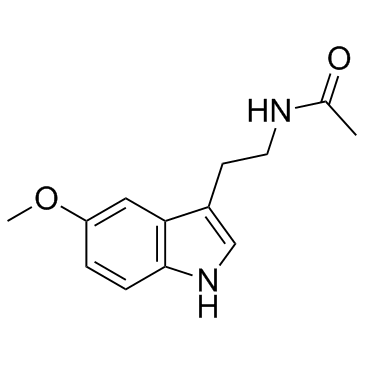Melatonine

Melatonine structure
|
Common Name | Melatonine | ||
|---|---|---|---|---|
| CAS Number | 73-31-4 | Molecular Weight | 232.278 | |
| Density | 1.2±0.1 g/cm3 | Boiling Point | 459.8±55.0 °C at 760 mmHg | |
| Molecular Formula | C13H16N2O2 | Melting Point | 116.5-118 °C(lit.) | |
| MSDS | Chinese USA | Flash Point | 231.9±31.5 °C | |
| Symbol |



GHS02, GHS06, GHS08 |
Signal Word | Danger | |
|
Cranberry flavonoids prevent toxic rat liver mitochondrial damage in vivo and scavenge free radicals in vitro.
Cell Biochem. Funct. 33 , 202-10, (2015) The present study was undertaken for further elucidation of the mechanisms of flavonoid biological activity, focusing on the antioxidative and protective effects of cranberry flavonoids in free radical-generating systems and those on mitochondrial ultrastruct... |
|
|
Oxidative damage of rat liver mitochondria during exposure to t-butyl hydroperoxide. Role of Ca²⁺ ions in oxidative processes.
Life Sci. 92(23) , 1110-7, (2013) The present study was designed for further evaluation of the biochemical mechanism of hepatic mitochondrial dysfunction under oxidative damages induced by organic hydroperoxide, tert-butyl hydroperoxide (tBHP), for estimation of the molecular targets impaired... |
|
|
Development of Man-rGO for Targeted Eradication of Macrophage Ablation.
Mol. Pharm. 12 , 3226-36, (2015) This study was aimed to develop and evaluate a smart nanosystem that targeted photothermal ablation of inflammatory macrophages in atherosclerotic plaque. Mannosylated-reduced graphene oxide (Man-rGO) was synthesized using three step procedures: (1) preparati... |
|
|
Interaction of pituitary hormones and expression of clock genes modulated by bone morphogenetic protein-4 and melatonin.
Biochem. Biophys. Res. Commun. 459(1) , 172-7, (2015) Functional interaction of clock genes and pituitary hormones was investigated by focusing on bone morphogenetic protein (BMP)-4 and melatonin actions in anterior pituitary cells. A significant correlation between the mRNA expression of proopiomelanocortin (PO... |
|
|
Protective Effects of Melatonin against Cyclophosphamide-induced Oxidative Lung Toxicity in Mice.
Drug Res. (Stuttg.) 65 , 281-6, (2015) This study was undertaken to evaluate the protective effects of melatonin against cyclophosphamide (CP)-induced oxidative lung toxicity in mice. Mice were pre-treated with various doses of melatonin for 7 consecutive days and were then injected with CP (200 m... |
|
|
Ceramide metabolism regulates autophagy and apoptotic cell death induced by melatonin in liver cancer cells.
J. Pineal Res. 59 , 178-89, (2015) Autophagy is a process that maintains homeostasis during stress, although it also contributes to cell death under specific contexts. Ceramides have emerged as important effectors in the regulation of autophagy, mediating the crosstalk with apoptosis. Melatoni... |
|
|
Effect of melatonin and analogues on corneal wound healing: involvement of Mt2 melatonin receptor.
Curr. Eye Res. 40(1) , 56-65, (2014) We have investigated the effect of melatonin and its analogues on rabbit corneal epithelial wound healing.New Zealand rabbits were anaesthetised and wounds were made by placing Whatman paper discs soaked in n-heptanol on the cornea. Melatonin and analogues (a... |
|
|
Melatonin prevents neural tube defects in the offspring of diabetic pregnancy.
J. Pineal Res. 59 , 508-17, (2015) Melatonin, an endogenous neurohormone secreted by the pineal gland, has a variety of physiological functions and neuroprotective effects. However, its protective role on the neural tube defects (NTDs) was not very clear. The aim of this study was to investiga... |
|
|
Melatonin Attenuates Oxidative Damage Induced by Acrylamide In Vitro and In Vivo.
Oxid. Med. Cell. Longev. 2015 , 703709, (2015) Acrylamide (ACR) has been classified as a neurotoxic agent in animals and humans. Melatonin (MT) has been shown to be potentially effective in preventing oxidative stress related neurodegenerative disorders. In this study, whether MT exerted a protective effe... |
|
|
Translating clinical findings into knowledge in drug safety evaluation--drug induced liver injury prediction system (DILIps).
J. Sci. Ind. Res. 65(10) , 808, (2006) Drug-induced liver injury (DILI) is a significant concern in drug development due to the poor concordance between preclinical and clinical findings of liver toxicity. We hypothesized that the DILI types (hepatotoxic side effects) seen in the clinic can be tra... |